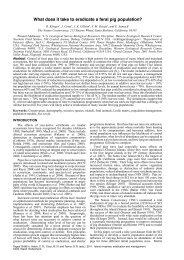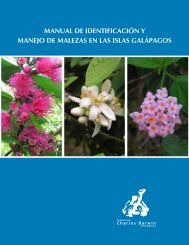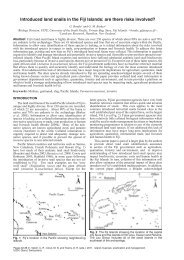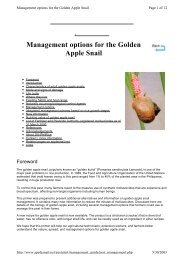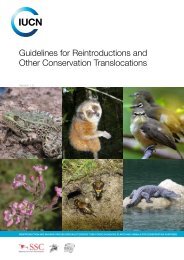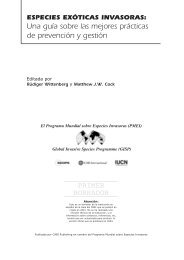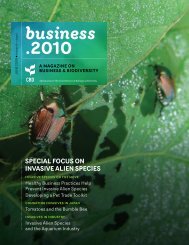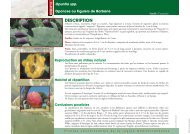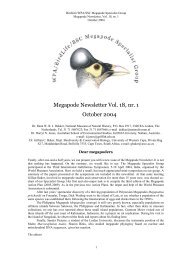Aliens Newsletter - ISSG
Aliens Newsletter - ISSG
Aliens Newsletter - ISSG
You also want an ePaper? Increase the reach of your titles
YUMPU automatically turns print PDFs into web optimized ePapers that Google loves.
The Eradication of Ruddy Ducks in the United Kingdom<br />
Iain Henderson<br />
The non-native Ruddy Duck Oxyura jamaicensis<br />
became established in the wild in the United<br />
Kingdom in the 1960s following escapes and<br />
releases from waterfowl collections. During the<br />
1970s and 1980s it spread into many areas of the<br />
UK and was seen with increasing frequency in<br />
mainland Europe. Hybridisation with the native<br />
White-headed Duck O. leucocephala was first<br />
recorded in Spain in 1991. Although the Whiteheaded<br />
Duck is classed as “endangered”, the<br />
population in Spain is heavily protected from<br />
hunting and habitat loss, so hybridisation with<br />
the Ruddy Duck is now regarded as the greatest<br />
threat to its long-term survival. Following several<br />
years of research, a programme aiming to<br />
eradicate Ruddy Ducks from the UK began in<br />
2005. Since then over 6,800 Ruddy Ducks have<br />
been culled across England, Scotland and Wales,<br />
and data suggest that by March 2010 the UK<br />
population had been reduced by over 95%.<br />
Introduction<br />
Figure 1. Male White-headed Duck.<br />
Photo: Joe Blossom<br />
The White-headed Duck Oxyura leucocephala is<br />
listed as Endangered on the IUCN Red List of<br />
Threatened Animals (Hughes et al. 2006; IUCN<br />
2009). This species was formerly found throughout<br />
southern Europe, parts of North Africa and much of<br />
Central Asia but its breeding areas are now highly<br />
fragmented, principally due to habitat loss and overhunting.<br />
The European breeding population is now<br />
restricted to Spain (see Figure 1 and 2), which is the<br />
only region where the White-headed Duck has expanded<br />
its breeding range and population size in recent<br />
years (Hughes et al. 2006). The Spanish population<br />
had fallen to as few as 22 birds at just one<br />
location by 1977 (Torres 2003), but recovered following<br />
a hunting ban which came into force in 1980.<br />
Habitat protection has safeguarded the key breeding<br />
and wintering sites for the species (Carlos<br />
Gutiérrez pers. comm.) and in recent years the postbreeding<br />
population has stabilised at between 2,100<br />
and 2,600 birds. In 2007 breeding occurred on 32<br />
sites in southern and eastern Spain (Carlos Gutiérrez<br />
pers. comm.).<br />
Figure 2. Main breeding and wintering sites for Whiteheaded<br />
Ducks in Spain<br />
<strong>Aliens</strong> 17



